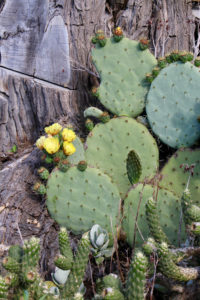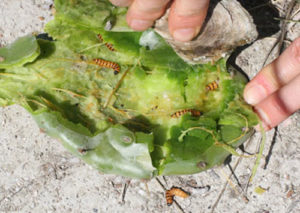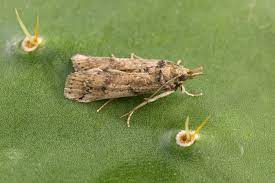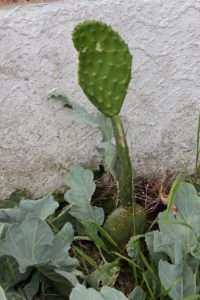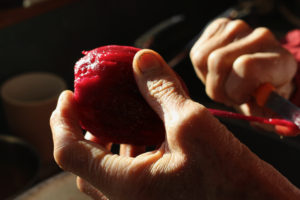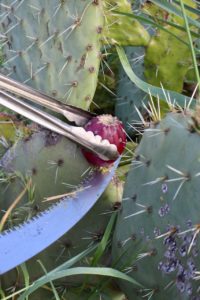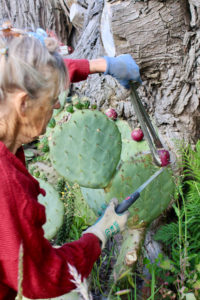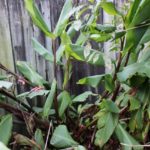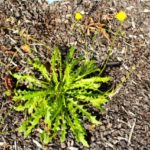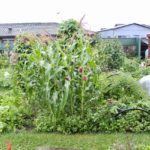Prickly pear cactus Opuntia stricta though not a weed on our shores of Aotearoa, in Australia has ruined the livelihoods of many farmers. It was
unstoppable in spreading for a decade until the 1920s, when its natural enemy the cactoblastis moth was introduced. Noxious in Australia, here we grow it for its bright yellow flowers, rich red fruits and dramatic appearance. There are 300 species some of whom have red or pink flowers. The best part is Opuntia holds nutritional and medicinal secrets beneath the mean exterior.
I first met this spiny, perennial shrub that grows up to 2 metres high with flattened stems rather than leaves, in Canterbury at my friend Vanya’s organic farm. All the flattened stems or pads are covered in vicious spines and tufts of minutely barbed glochids (hairs). These are easily dislodged and stick to the skin if touched. They’re difficult to see and remove and can cause discomfort. To handle them use thick gloves.
Vanya grows her plants close to a pine tree hedge (but not in the shade) where it is dry. They are drought tolerant and cold hardy. She has another huge one growing in the open around a dead tree stump where it thrives. To propagate new plants Vanya cuts a pad off with a piece of the pad below still attached and pokes it in the soil. Vanya wants lots of them for the gorgeous rich red fruits the mature plants produce. She values these fruits for their nutritional qualities and as a survival food.
I now have a plant in my garden that is three pads high. Despite the spines and hairs snails manage to munch into the pads and have even made a hole. This is a sign that there is something worth eating and indeed the pads can be eaten like a vegetable and are popular in Mexican dishes. You have to remove the spines with a knife and peel the glochids using a potato peeler. They can be cut into strips, boiled for five minutes to remove the mucilaginous texture (although I don’t mind that), and pan fried. They are said to taste a cross between a green bean and asparagus.
I’m looking forward to the large lemon-yellow flowers as then it will produce the succulent red fruit which can be made into jams and jellies
and they’re also wonderful medicine. The slimy/mucilaginous juice of the fruit made into a syrup forms a sticky protective coating over a sore throat. In 1925 in New South Wales a local doctor had success treating diabetic patients with a solution he made by soaking the shredded pads in water overnight, then straining the pulp through a sieve. The patients drank a glassful before meals. Theysaid it was ‘unpleasant and slimy to taste’, but the doctor declared ‘there is not a slightest doubt about its value’[1].
The process of picking the fruit Vanya has perfected using long tongs, a
saw and gloves. Once picked she holds the fruit with the tongs under a running tap of water and scrubs the spines and hairs off with a stiff brush. Then she peels the fruit and the reward is eating the sweet, juicy, slippery flesh with black stones which one can swallow or spit out. They’re too hard to chew but the seeds can be roasted and ground into a powder.
I love how there is always something new to learn.
[1] The Magic and Medicine of Plants, Readers Digest, 2010.
